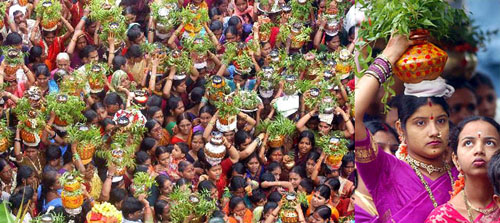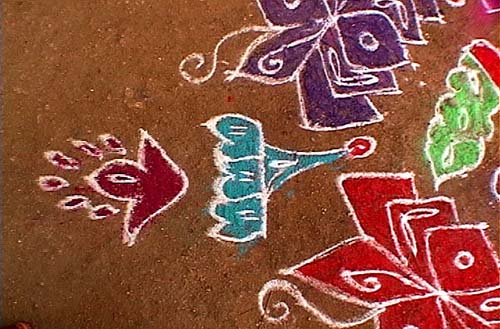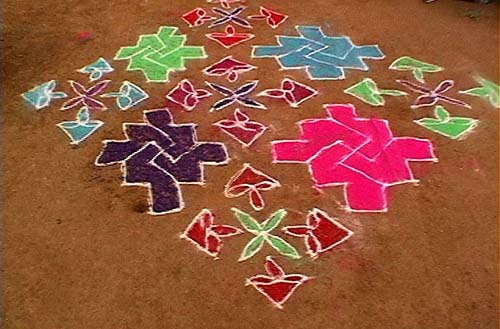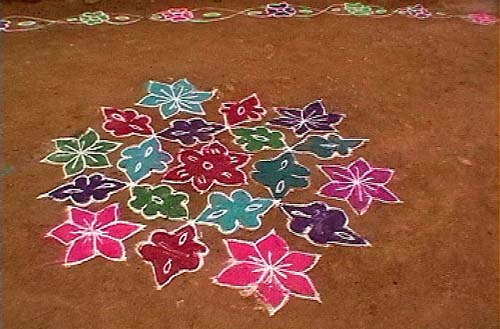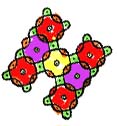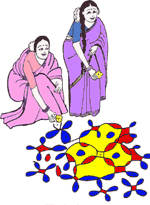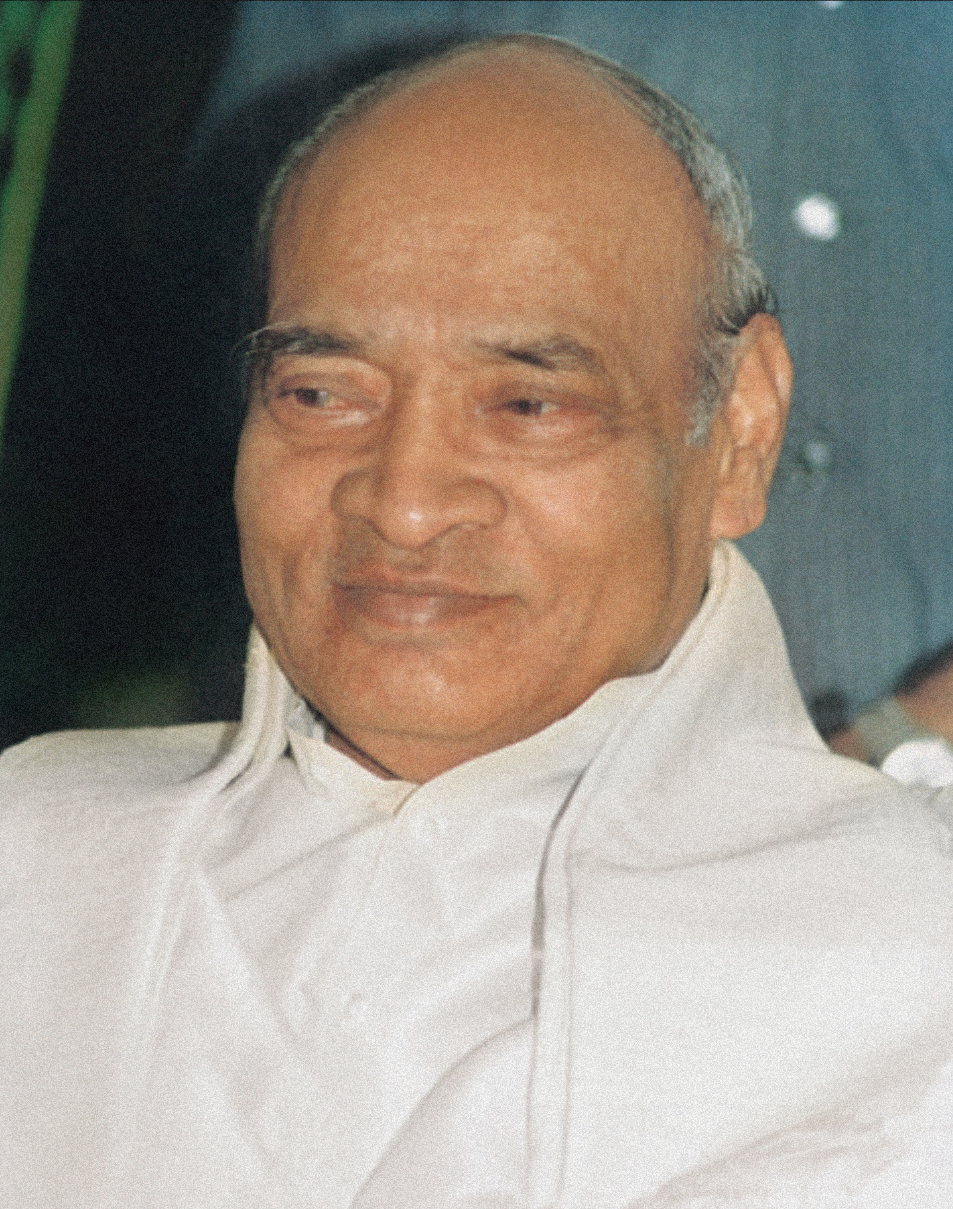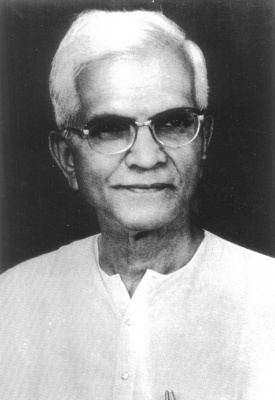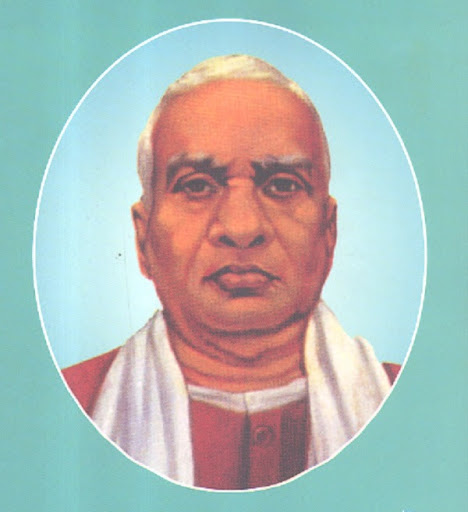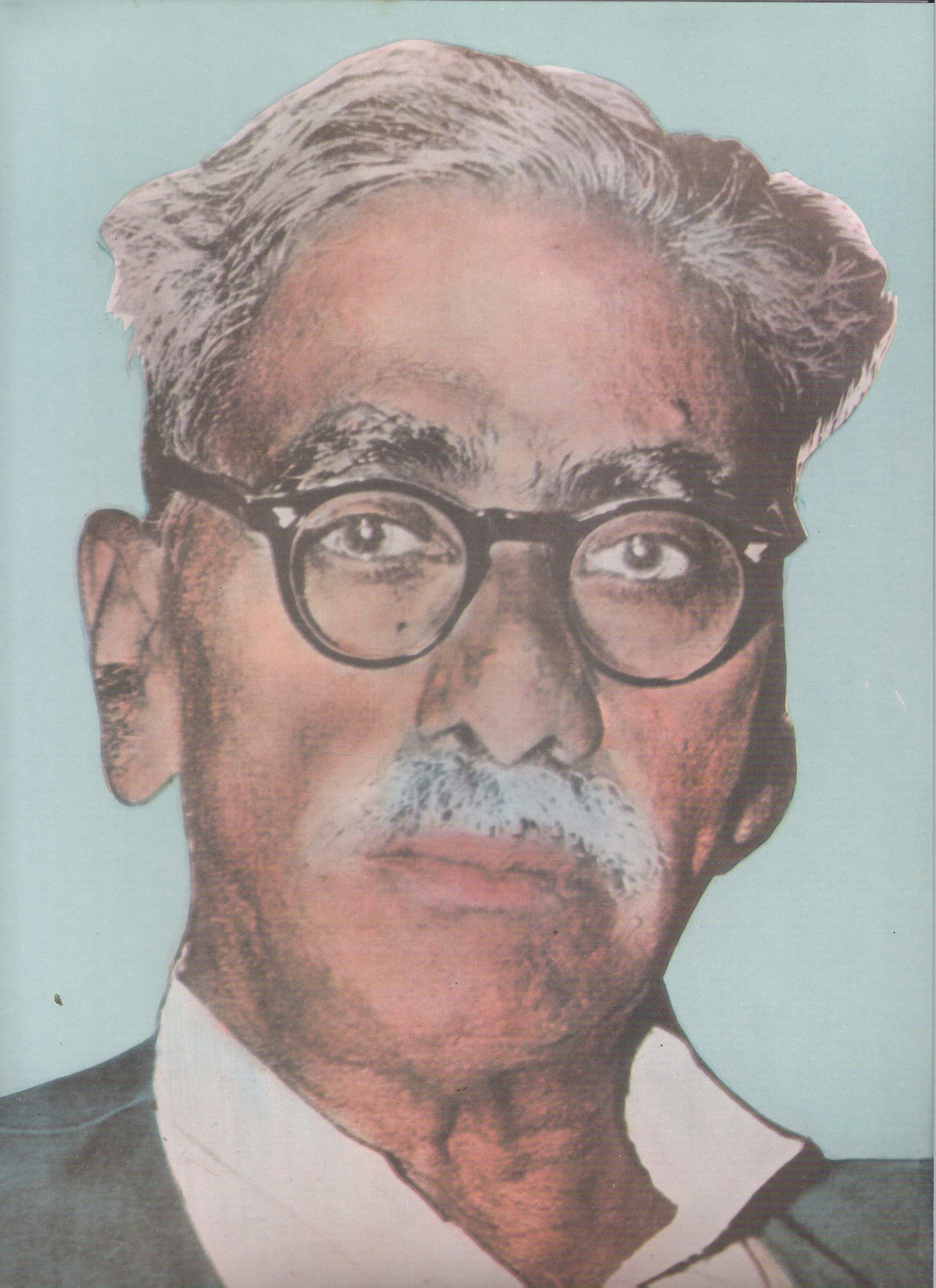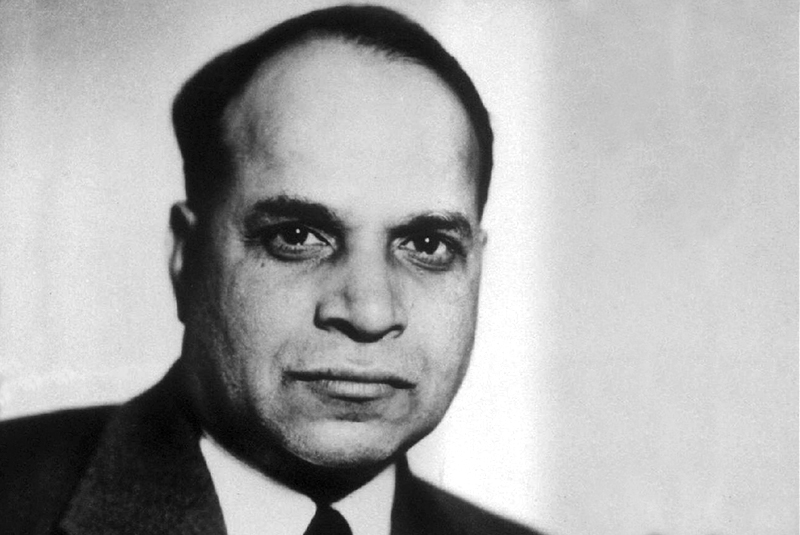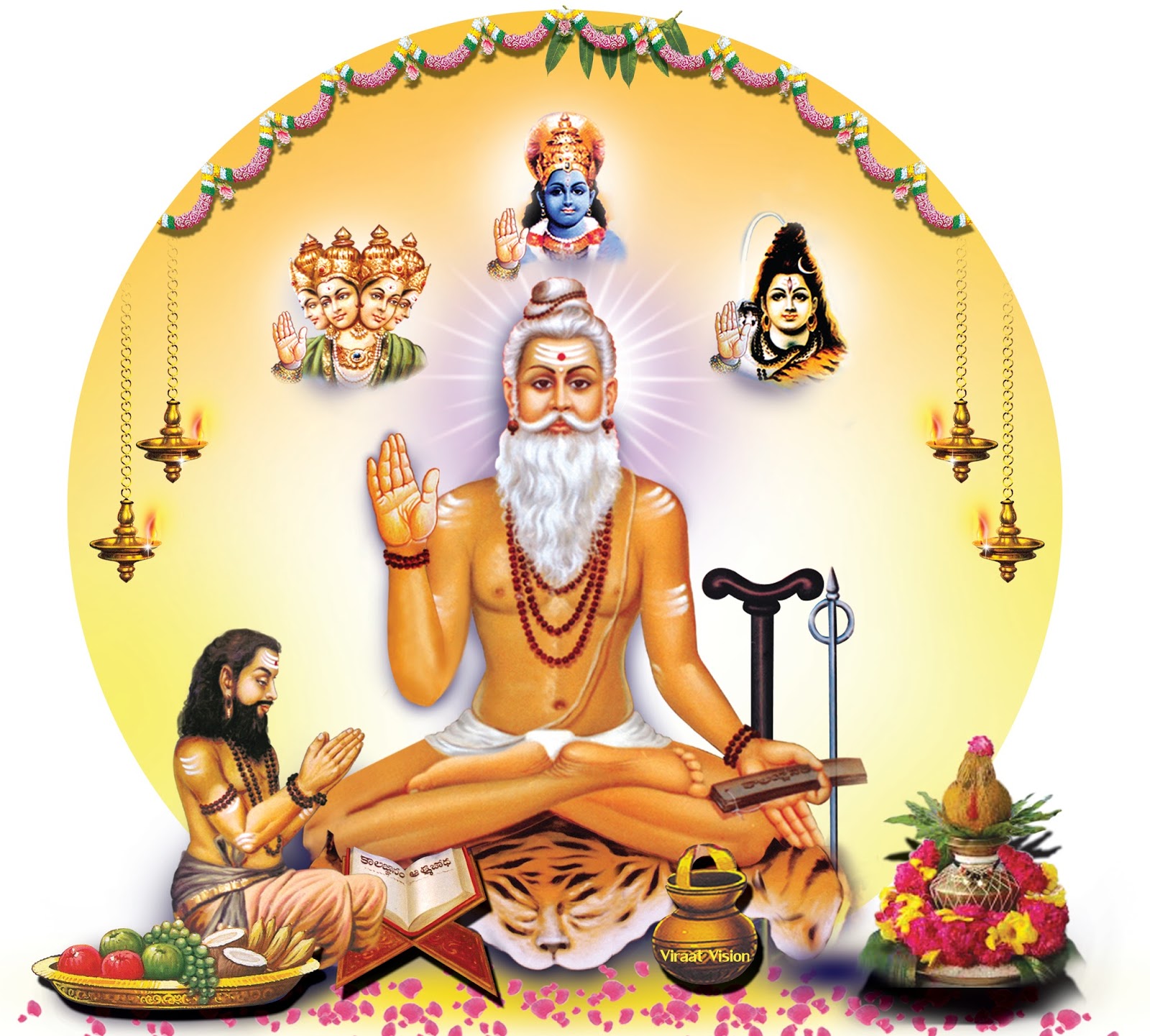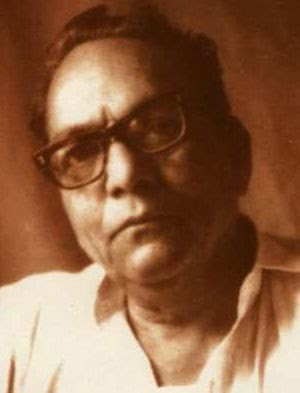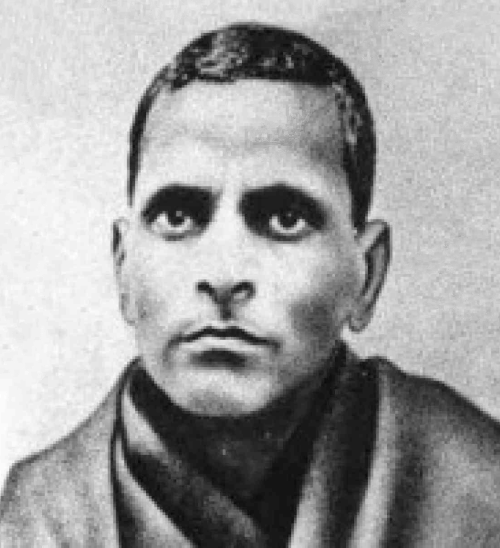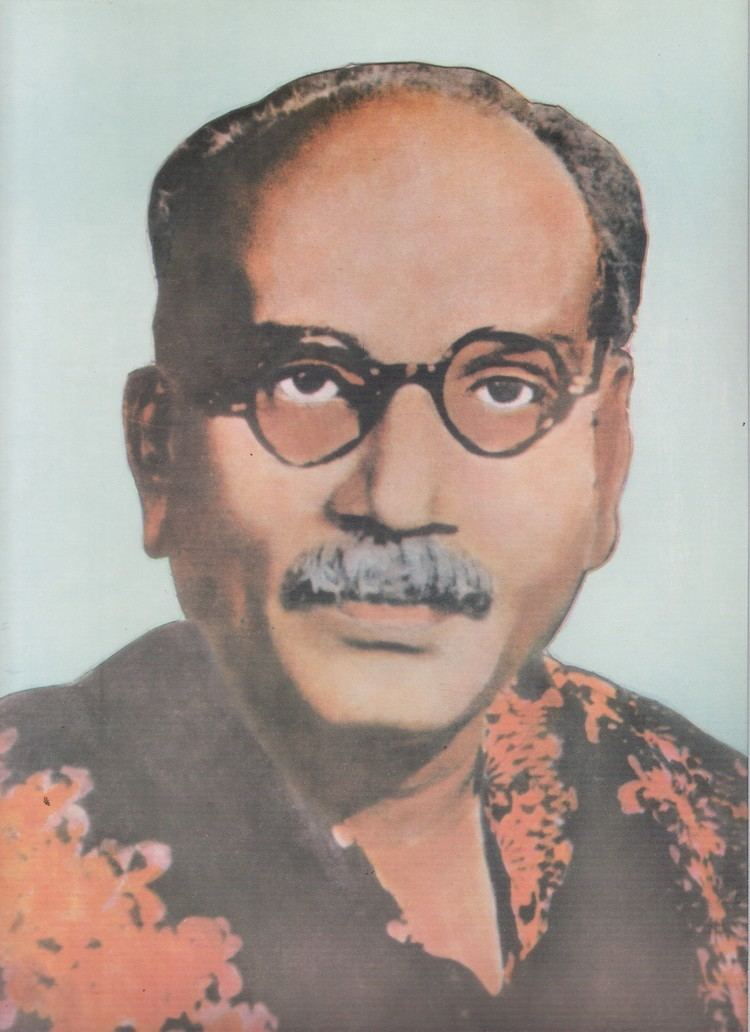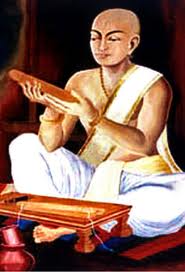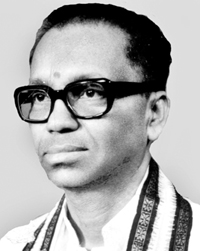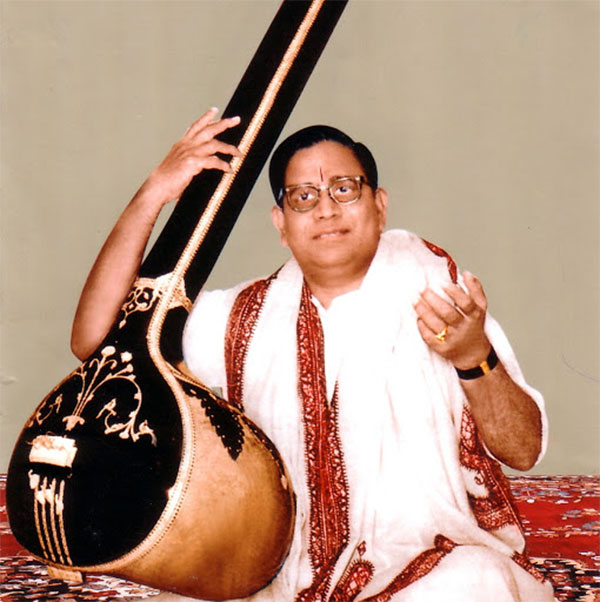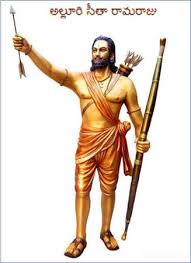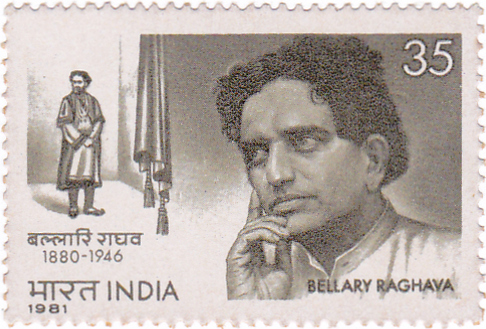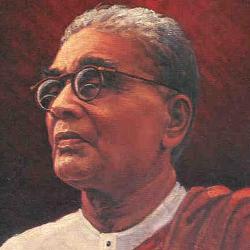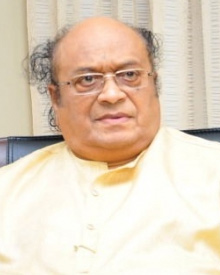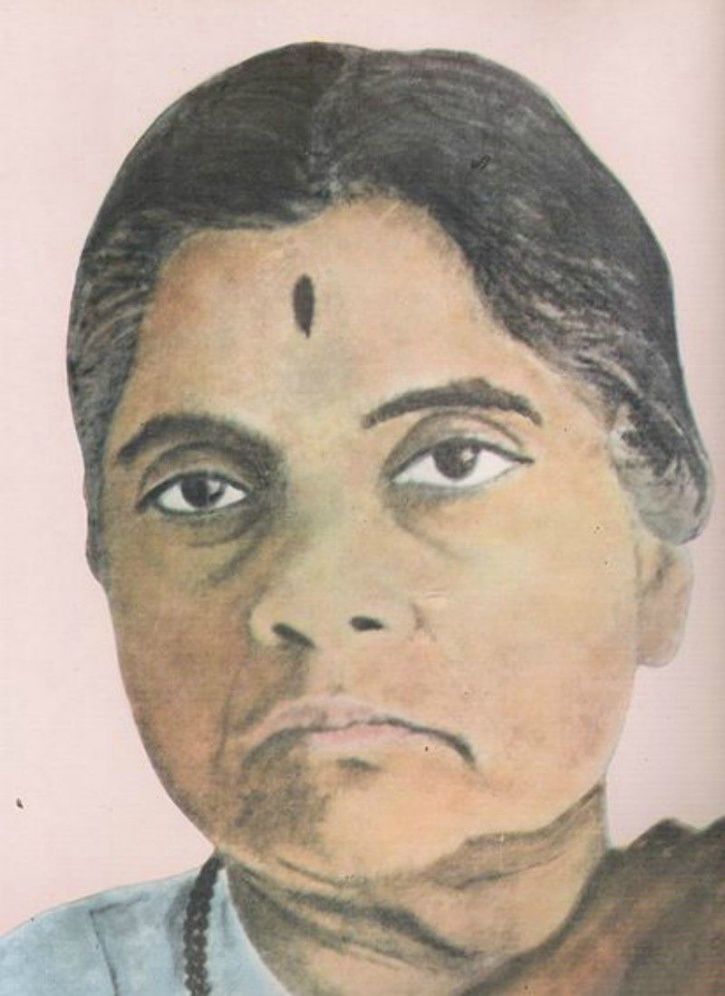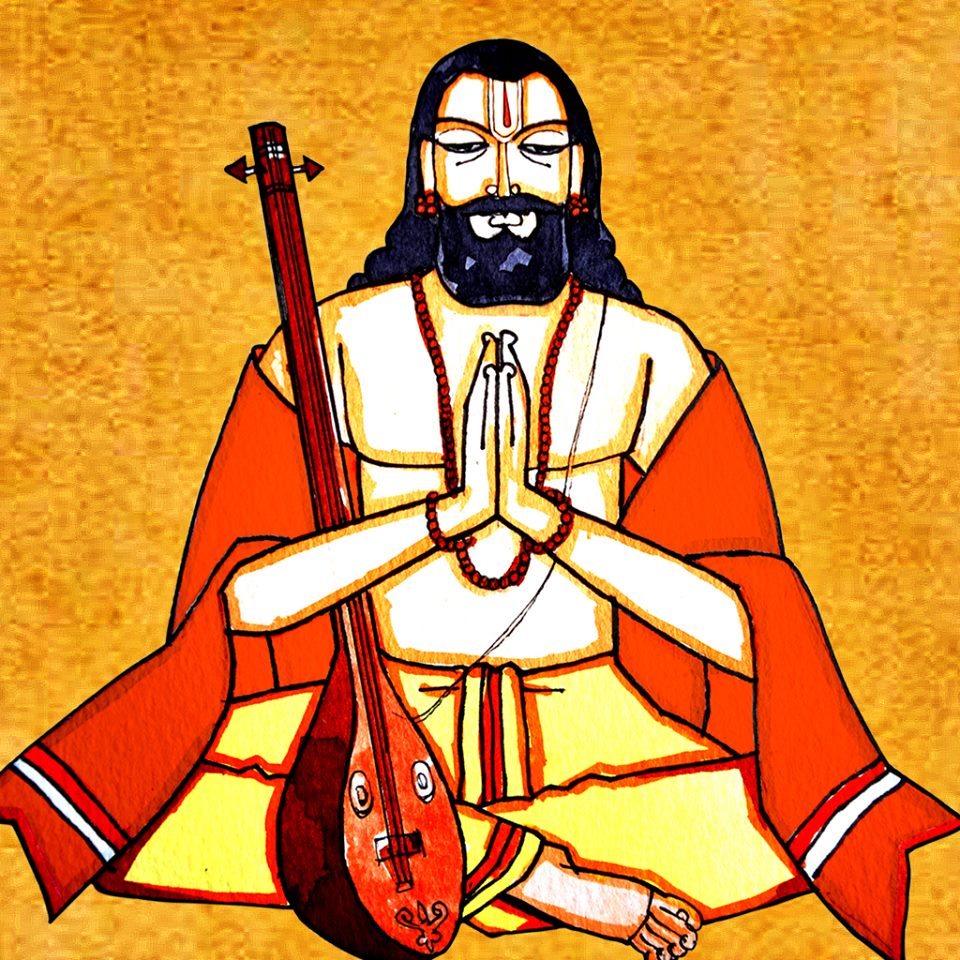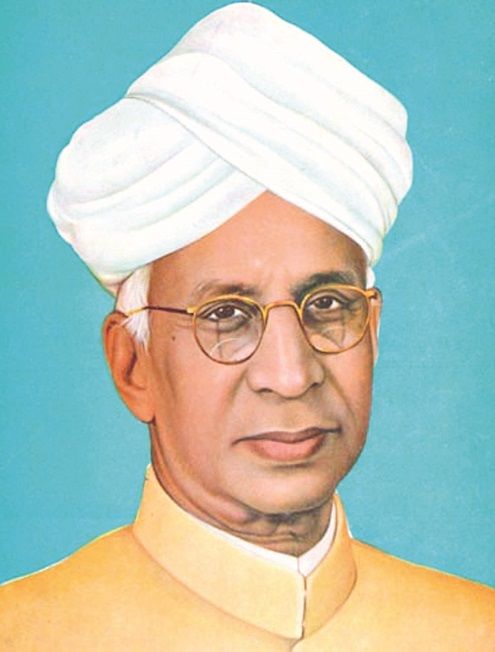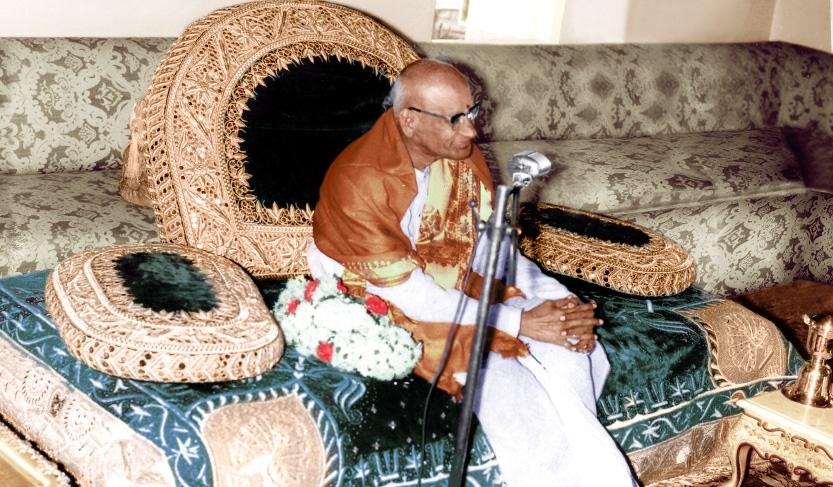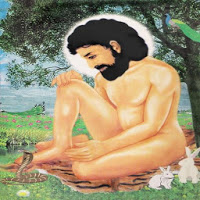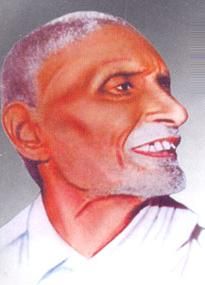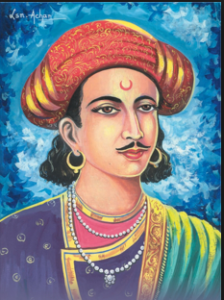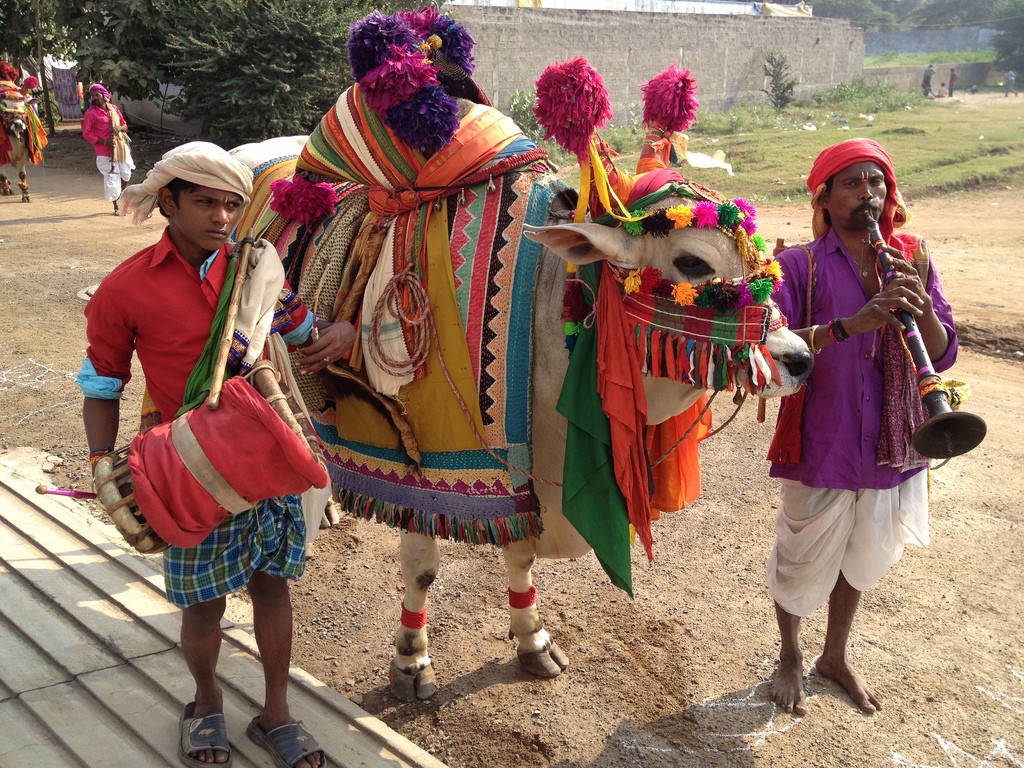
Makar Sankranti marks the commencement of the Sun’s journey to the Northern Hemisphere (Makara raasi ), signifying the onset of Uttarayana Punyakalam, and is a day of celebration all over the country. The day begins with people taking holy dips in the waters and worshipping the Sun. Traditionally, this period is considered an auspicious time and the veteran Bhishma of Mahabharata chose to die during this period. Bhishma fell to the arrows of Arjun. With his boon to choose the time of his death, he waited on a bed of arrows to depart from this world only during this period. It is believed that those who die in this period have no rebirth.
The Indo Gangetic plain begins this day with taking dips in the Ganga and offering water to the Sun god. The dip is said to purify the self and bestow punya. Special puja is offered as a thanksgiving for good harvest. According to folklore, girls who take the holy dip get handsome husbands and boys get beautiful brides. Til and rice are two important ingredients of this festival. In the rice-eating belt of Bihar and eastern Uttar Pradesh, people have a special rice-centric meal on this day. Also known as Gangasagar Mela, on this day, people come from all over India for a ceremonial cleansing in the river Hooghly, near Calcutta. In Maharashtra, when two persons greet each other on this festive day, they exchange a few grains of multi-coloured sugar and fried til mixed with molasses and say “til gud ghya, god god bola” (henceforth, let there be only friendship and good thoughts between us).


In Gujarat, the pandits consider Sankranti as an auspicious day to grant scholarships and certificates of merit to students who have successfully completed their studies in philosophy. In a Hindu household, new utensils are purchased and used for the first time. Brightly coloured kites dot the skies on this day.
In Karnataka, men, women and children attired in colourful tunics visit friends and relatives and exchange pieces of sugarcane, a mixture of fried til, molasses, pieces of dry coconut, peanuts and fried gram.
The significance of this exchange is that sweetness should prevail in all the dealings. As part of the festival, cows and bulls are given a wash and the horns are painted with bright colours and decorated with garland, and are taken in a procession in the village to the accompaniment of pipes and drums. In the night a bonfire is lit and the animals are made to jump over the fire.
It is a big event for the Tamils and the people of Andhra Pradesh. The Telugus like to call it ‘Pedda Panduga’ meaning big festival. The whole event lasts for four days, the first day Bhogi, the second day Sankranti, the third day Kanuma and the fourth day, Mukkanuma.
One month preceeding Sankranti is called Dhanurmasam and is also an auspicious period. People wake up early, take bath and go around the streets singing devotional songs. Houses are whitewashed and farmers clean their warehouses. Colorful rangoli (muggulu) are drawn in the front yards of every house during this month. These artistic floral designs are drawn on the floor with rice flour or fine powder from limestone. These patterns are decorated with marigold placed on cowdung balls. Colorfully dressed young girls go round them singing songs.


Sankaranthi Muggulu

Pongal is celebrated on the same day as Bihu, Lohri and Bhogi. But Pongal stretches over four days. The word Pongal literally means “boiling over” and celebrates the bounteous crops in the fields. This festival is the biggest event of the year for the Tamils as well as for the people of Andhra Pradesh.The first day, Bhogi-Pongal is devoted to Bhogi or Indran, the rain god. The day is linked with the famous mythological tale about Krishna lifting Gobardhan parbat on his little finger. The day begins with a til oil bath and in the evening there is a bonfire made of old cloths, files, mats and rugs.
The second day, Surya-Pongal, is dedicated to the Sun (Surya). On this day, pongal (rice cooked in milk and jaggery) is bolied by women who offer it to the Sun.
Mattu-Pongal, the third day, is the day dedicated to the worship and veneration of cattle (mattu). The horns of the cattle is decorated with turmeric and kumkum, small bells and flowers are hung around their neck and they are paraded in the streets. The pongal that has been offered to the local deities is given to the cattle to eat.


The last day is known as Kanyapongal. Coloured balls of the pongal are made and are offered to birds. A kind of bull-fight, called the ‘Jallikattu’ is held in Madhurai, Tiruchirapalli and Tanjore in Tamil Nadu and several places in Andhra Pradesh. Bundles containing money are tied to the horns of ferocious bulls, and unarmed villagers try to wrest the bundles from them. Bullock Cart race and cock-fight are also held. In Andhra Pradesh, every household displays its collection of dolls for three days. Community meals are held at night with freshly harvested ingredients.

All over India, Maha Shivratri occurs on the 14th night of the new moon during the dark half of the month of Phalguna. On a moonless night in February every year, occurs the night of Shiva, the destroyer. This is the night when He is said to have performed the Tandava or the dance of primordial creation, preservation and destruction.
Devotees of Shiva fast during the day and maintain a long vigil during the night. In temples all across the country, bells ring, sacred texts are chanted and traditional offerings of leaves and milk are made to the Shiv lingam, the phallic symbol of the god. There is a legend behind Shiva’s phallic form. It is believed that once Brahma and Vishnu, the two pillars of the holy Trinity were having an argument as to who was supreme.
Brahma declared himself to be the Creator of all and thus more revered. Vishnu claimed that since he was the Creator and the Destroyer, he commanded more respect. At that moment a huge lingam ablaze with flames appeared from nowhere. Both the gods were so overwhelmed by its constantly increasing size, that they forgot their quarrel and decided to determine its size. Vishnu took the form of a boar and went to the netherworld while Brahma in the form of a swan ascended to the skies. Neither could ascertain the size. Just then, Shiva appeared out of the lingam and proclaimed that he was the progenitor of both of them. He was the Creator, Preserver and the Destroyer. He demanded that thereafter he be worshipped in his phallic form, the lingam.
On the day of Shivratri, the lingam is bathed with the five sacred offerings of a cow, called the panchagavya – milk, sour milk, urine, butter and dung. Thereafter the five foods of immortality – milk, clarified butter, curd, honey and sugar – are placed before the lingam. Dhatura and jati, though poisonous fruits, are believed to be sacred to Shiva and thus offered at his temple. Eleven is considered to be the sacred number of the Lord. Devotees keep a fast (vrat) on Shivratri and observe strict rules, for vardan (boon).
Special celebrationa are held at important Shiva temples at Chidambaram, Kalahasi Khajuraho and Varanasi. Worship of Shiva is to release the worshipper
from the cycle of birth and rebirth. In Kashmir, the festival is held for 15 days; the thirteenth day is observed as Herath, a day of fast followed by a family feast.

It is spring time in India, flowers and fields are in bloom and the country goes wild with people running on the streets and smearing each other with brightly hued powders and coloured water. This is the festival of Holi, celebrated on the day after the full moon in early March every year.
Originally Holi is a festival to celebrate good harvests and fertility of the land. There are many legends concerning the origin of this spring festival.
The most popular among these concerns Prince Prahlad, the god-fearing son of the evil King Hiranyakasipu. Prahlad did not give up worshipping the god Vishnu in spite of fearful persecution by his father and his demon aunt Holika, who was deputed by her brother to kill young Prahlad. Ultimately, when Holika who was immune to death by fire, took Prahlad and entered a blazing furnace built for his destruction, it was the wicked Holika who was burnt to ashes by divine intervention, while Prahlad came out unscathed. Before she died, she realised her follies and begged the boy’s forgiveness. As his gesture of forgiveness, Prahlad deemed that her name would be remembered at least one day in the year. Holi commemorates this event from mythology, and huge bonfires are burnt on the eve of Holi as its symbolic representation. This exuberant festival is also associated with the immortal love of Krishna and Radha. The young Krishna would complain to his mother Yashoda about why Radha was so fair and he so dark. Yashoda advised him to apply colour on Radha’s face and see how her complexion would change. Holi is celebrated with particular gaity in the villages around Mathura, the birth-place of Krishna.
Down the ages, civilisation has advanced leaps and bounds, but the spirit of Holi remains the same. Each year, without fail, the old and the young alike, gather into groups and indulge in a riot of colours.
Holi is also synonymous with bhang, which is consumed by many in the form of laddoos and ghols. One could get away with almost anything on this day; squirting coloured water on passers-by and dunking friends in the mud pool saying “bura na mano, Holi hai” (don’t feel offended, it’s Holi)
Apart from this usual fun with coloured powder and water, Holi is marked by vibrant processions which are accompanied by folk songs, dances and a general sense of abandoned vitality.
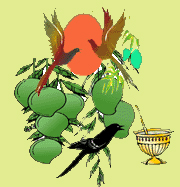
According to Hindu Mythology, the sixty Telugu Namasamvastharas are being repeated from time to time.
It is believed that the creator of the Hindu pantheon Lord Brahma started creation on this day – Chaitra suddha padhyami or the Ugadi day. Also the great Indian Mathematician Bhaskaracharya’s calculations proclaimed the Ugadi day from the sunrise on as the beginning of the new year,new month and new day.
The onset of spring also marks a beginning of new life with plants(barren until now) acquiring new life, shoots and leaves. Spring is considered the first season of the year hence also heralding a new year and a new beginning. The vibrancy of life and verdent fields, meadows full of colorful blossoms signifies growth, prosperity and well-being.
‘Ugadi’ as the name ‘Yug-Adi’ suggests is celebrated on the first day of the first month of Telugu Year i.e. Chaitram. This day is celebrated as New Year Day by the people of Andhra Pradesh. This day is known for its ‘Ugadi Pacchadi’ preparation comprising of six tastes (shadruchi sammelan), each standing for a special character a man experiences in life. The ingredients of this preparation, though of different tastes or characters when mixed in definite proportions result in a delicious dish. The underlying idea conveys that the six faces of life mentioned underneath, should be handled by man and balanced in such a way as to make his life a beautiful one on earth.
People celebrating this festival are supposed to wake up early in the morning at about 5 am. and have a head bath. Being a new festival it demands kith and kin to wear new clothes. Elder woman of the house prepares Ugadi Pacchadi Prasadam (Ugadi Sammelan) and distributes it to all the members of the family
Prasadam is to be taken with an empty stomach as to have a balanced life all through the year. A delicious lunch comprising of Garelu, Pulihora (Yellow rice), Payasam(Kheer), etc. follows.
This auspicious day is also known for its “Panchang Sravanam” chanted by Veda Pandits. Panchaang contains astronomical data relating to the position of the Sun, The Moon, Planets, Stars and details of Eclipses, Occultations, Raasi results, Muhurtams etc. for one complete year (usually from April to March).
It is a customary practice to attend the temple in the evening of this day where a Siddhanthi (Pandit) recites Panchanga Sravanam. The yearly fore cast for the country as a whole, different places and people basing on Raasis will be predicted. It is believed that listening to Panchanga Sravanam does good to the people.
Preparing for the Occasion
Preparations for the festival begin a week ahead. Houses are given a thorough wash. Shopping for new clothes and buying other items that go with the requirements of the festival are done with a lot of excitement.
Ugadi is celebrated with festive fervor in Maharashtra, Karnataka and Andhra Pradesh. While it is called Ugadi in A.P. and Karnataka, in Maharashtra it is known as “Gudipadava”.
On Ugadi day, people wake up before the break of dawn and take a head bath after which they decorate the entrance of their houses with fresh mango leaves. The significance of tying mango leaves relates to a legend. It is said that Kartik (or Subramanya or Kumara Swamy) and Ganesha, the two sons of Lord Siva and Parvathi were very fond of mangoes. As the legend goes Kartik exhorted people to tie green mango leaves to the doorway signifying a good crop and general well-being.
It is noteworthy that we use mango leaves and coconuts (as in a Kalasam, to initiate any pooja) only on auspicious occasions to propitiate gods. People also splash fresh cow dung water on the ground in front of their house and draw colorful floral designs. This is a common sight in every household. People perform the ritualistic worship to God invoking his blessings before they start off with the new year. They pray for their health, wealth and prosperity and success in business too. Ugadi is also the most auspicious time to start new ventures.
The celebration of Ugadi is marked by religious zeal and social merriment. Special dishes are prepared for the occasion. In Andhra Pradesh, eatables such as “pulihora”, “bobbatlu” and preparations made with raw mango go well with the occasion. In Karnataka too, similar preparations are made but called “puliogure” and “holige”. The Maharashtrians make “puran poli” or sweet rotis.
Season For Pickles
With the raw mango available in abundance only during the two months (of April/May), people in Andhra Pradesh make good use of mangoes to last them until the next season. They pickle the mangoes with salt, powdered mustard and powdered dry red chilli and a lot of oil to float over the mangoes. This preparation is called “avakai” and lasts for a whole year.
Mangoes and summer season go hand in hand. Ugadi thus marks the beginning of the hot season which coincides with the school vacations. For the young ones, therefore, Ugadi is characterised by new clothes, sumptuous food and revelling. The air is filled with joy, enthusiasm and gaiety. Some people participate in social community gatherings and enjoy a tranquil evening with devotional songs (bhajans).
Kavi Sammelanam
Kavi Sammelanam (poetry recitation) is a typical Telugu Ugadi feature. Ugadi is also a time when people look forward to a literary feast in the form of Kavi Sammelanam. Many poets come up with new poems written on subjects ranging – from Ugadi – to politics to modern trends and lifestyles.
Ugadi Kavi Sammelanam is also a launch pad for new and budding poets. It is generally carried live on All India Radio’s Hyderabad “A” station and the Doordarshan,(TV) Hyderabad following “panchanga sravanam” (New year calendar) narrating the way the new year would shape up in the lives of people and the State in general. Kavis (poets) of many hues – political, comic, satirical reformist, literary and melancholic – make an appearance on the Ugadi stage. Ugadi is thus a festival of many shades. It ushers in the new year, brings a rich bounce of flora and fills the hearts of people with joy and contentment.
UGADI PACHCHADI
Ingredients:
2 tea spoon broken new jaggery / brown sugar.
1 1/2 tea spoon new tamarind .
1 1/2 tea spoon mango pieces chopped small.
1 tea spoon neem flowers.
1 cup water.
Method:
Soak Tamarind for about 15-20 minutes in a cup of water. Extract tamarind juice by squeezing the pulp and straining the juice from it. Dissolve the broken new jaggery into it. Then add the tiny mango pieces and the neem flowers. This is usually offered to the Gods during pooja and later everyone part takes this as prasadam and the first item to be eaten on Ugadi day.

On Chaitra Sukla Navami (the ninth day of the bright half of Chaitra) ‘Sree Ramanavami’ is celebrated. Sree Rama was born on this day and years later on the same day Rama married Sita. ‘Sree Sitarama Kalyana Mahotsav’ (wedding) is performed in the abode Sitarama Temple, Bhadrachalam, Khammam District, Andhra Pradesh with great tradition and Bhakti. On behalf of Andhra Pradesh Government, Chief Minister with his wife visits the Kalyana Mahotsav and offers Silk Clothes and Pearls as Talambralu (auspicious) to the God and Goddess. The whole of this celebration is telecasted live in Doordarshan “Wherever four Hindus live, Rama and Sita will be there” so said Swami Vivekananda, one of the foremost harbingers of modern national renaissance of Bharat. The reverse also is equally true – wherever Rama and Sita live, the people there will remain and live as Hindus.
Every hill and rivulet of Bharat bears the imprint of the holy feet of Rama and Sita. Sri Rama reigns supreme to this day in the hearts of our people, cutting across all barriers of province, language, caste or sect.
Even the tribes living in isolated valleys and jungles have names like Mitti-Ram and Patthar-Ram. In some other tribes, every name carries the proud suffix of Ram, such as Lutthu Ram, Jagadev Ram, etc. In many northern parts of Bharat mutual greetings take the form of Jay Ramjee Ki.
Sri Rama has become so much identified with all the good and great and virile qualities of heroic manhood that expressions such as ‘Us me Ram nahi hai’ (there is no Rama in him) – meaning that a person has lost all manliness and worth – have become common usage. And when a Hindu quits the world stage, he is bid God-speed in his onward journey with Ramanama satya hai or Raghupati Raghava raja Ram, patita paavana Sita Ram. In fact, the latter couplet has become the nation’s bhajan par excellence.
Sri Rama’s story, Ramayana, has been sung and resung in all the languages and dialects of Bharat. The tradition of writing epics centering round the saga of Rama’s achievements started by Valmiki in Sanskrit and was continued by Tulsidas in Hindi, by Kamban in Tamil, by Ramanujan in Malayalam, by Krittivasa in Bengali and Madhav Kambali in Assamia and in fact, in almost every Bharatiya language. The tradition is being continued up to the present day. The Ramayana Darshanam of K.V. Puttappa, the national literary award of Bharat by the Jnana Peeth. The enchanting Geet Ramayana composed in Marathi by G.D. Madgulkar and set to tune by Sudhir Phadke is now thrilling the hearts of millions in Maharashtra.
The various tribal groups too have sung the story of Ramayana in their dialects. Sri Rama, Lakshmana and Janaki mirror the ideals for millions of tribal boys and girls. The Khamati tribe in Arunachal Pradesh, which is Buddhist, depicts Ramayana as the story narrated by Buddha to his first disciple, Ananda, and carries the universal message of Buddha. How deeply significant that every group and sect even in distant and far-flung parts of Bharatavarsha should have found a radiant reflection of its own ideals in the form of Sri Rama!
The comparison of Sri Rama’s fortitude to Himalayas and the grace and grandeur of his personality to the ocean – ‘Samudra iva gaambheerye, dhairye cha Himavaan iva’ – portrays how inseparably his personality has been blended into the entire national entity of Bharat.
Where in lay the secret of this unique greatness in Rama’s personality? He is called Maryaada-Purushottama – the great one who never deviated from the norms set by Dharma. In the eyes of the Hindu, the touchstone of human excellence is Dharma. Devotion to Dharma came first in Rama’s life and considerations of his personal joys and sorrows came last. It was his supreme commitment to putra-dharma (duty of a son) that made Rama smilingly depart to the forest for fourteen years at the bidding of his father. And this he did on the very day he was to be anointed as the future emperor of Bharat. He would not budge from the path of Dharma – righteousness – even when his own preceptor, his parents, his brothers and the whole body of his subjects tried to dissuade him. He upheld the supremacy of Dharma in every one of his human relationships and hence became an ideal son, an ideal brother, an ideal husband, an ideal disciple, an ideal friend, an ideal kind and even an ideal foe.
The one and supreme concern of Sri Rama’s life was the welfare of his subjects. He would forsake everything else to uphold his kingly duties – the Rajadharma. The night previous to his scheduled coronation, when Rama and Sita were alone in a happy mood in view of the next day’s joyous occasion, Sita asked Rama, “What is that thing which hold dearest to your heart?” Rama fell serious for a moment and said, “Dear Sita, you know I love you most dearly, but I love the subjects of Ayodhya more and if their welfare demands, I would not hesitate to sacrifice even you!” The following couplet conveying this idea is cited often:
Sneham dayaam cha soukhyam cha yadi vaa Jaanakimapi|
Aaraadhanaaya lokasya munchate naasti me vyathaa||
And Sri Rama did live up to his words. When he felt that the call of his royal duties – Rajadharma – demanded the forsaking of Sita, he wavered not in carrying it out. The most crucial test came when Lakshmana violated the orders of Rama and admitted Durvasa to Rama’s presence with a view to averting the destruction of Ayodhya by Durvasa’s curse. Rama stuck to the law of the land and awarded death penalty to Lakshmana – one whom he loved dearer than his own life. It was with such a fiery faith that Rama followed the dictates of Dharma.
To such a one, how could power and pelf hold any fascination? When Bharata came to him in the forest and implored him to return to Ayodhya and become the emperor, Sri Rama firmly refused. Here was enacted a scene unparalleled in the annals of world history – each of the two brothers trying to out-argue the other to make him accept the emperorship of a great and mighty kingdom.
Sri Rama’s role as one of the first and foremost national unifiers of Bharat is also unique and extraordinary. He embraced Guha, the forest King and ate in his house without the least hesitation. No sense of high or low ever touched his all-embracing love of his people. He even enjoyed a fruit tasted and offered with devotion by Shabari, a tribal lady in the far south.
The Vanaras or the forest-dwellers too felt that Rama was their own. He endeared himself to them so intimately that they became, in fact, his chief allies against Ravana. All over Bharatavarsha, the dear, little squirrel with its three brown stripes bespeaks the devotion to Sri Rama even among the animal world. Along with the Vanaras, a solitary squirrel had played his humble part in carrying sand for the construction of bridge to Lanka and Sri Rama’s caressing of the little one on the back had left those indelible stripes for all future generations.
Sri Rama’s intense adoration for the motherland has been immortalized by a legendary couplet which is playing on the lips of millions even to this day: Janani janmabhoomischa swargaadapi garreyasi (the mother and the motherland are to me greater than the heavens themselves).
The story of Rama is not that of a single towering personality dwarfing all others. The other characters like Sita, Lakshmana, Bharata and Hanuman too shine in their own greatness. All of them are so closely interwoven with Sri Rama’s life and achievements that it is well-nigh impossible to think of any one without the other. In fact, the most popular picture of Sri Rama, i.e., of Sri Rama Pattabhisheka includes Sita, Hanuman and all his brothers. And in the bringing out of the greatness of all these partners of his life-drama, Rama’s instinctive recognition of their merit and virtues played no mean part. He would always be the first to openly appreciate the unique and noble traits in others’ character. Even for Kaikeyi, who was responsible for his banishment to forest, Rama had only words of kindness. And as for Ravana, the abductor of his wife, Rama’s unstinted praise of his erudition and prowess at once lifts the story of Ramayana to heights unsurpassed in the annals of human history.
No wonder, the story of Sri Rama has crossed the boundaries of Bharat and inspired by many a distant people, their culture and literature. Indonesia – with Muslims forming 80% of her population – continues to adore Rama and Sita as her great cultural standard-bearers, and Ramayana as her national epic par excellence. Indonesia also prides herself in having the biggest drama stage in the world – with Ramayana as its chief attraction. And the credit goes to that country for celebrating the very first grand World Ramayana Festival some years ago.
The birthday of Sri Rama, indeed, signifies an event worth of remembrance by every one, whatever his country or race or religion, who cherishes the time honored sublime values of human culture and civilization.

Date : It is celebrated as the birth anniversary of Ganesha, the god of wisdom and prosperity on the fourth day of Bhadrapadamasam (August/September)
Legends : Ganesha is the god of wisdom and prosperity and is invoked before the beginning of any auspicious work by the Hindus. According to mythology he is the son of Shiva and Parvati, brother of Kartikeya – the general of the gods, Lakshmi – the goddess of wealth and Saraswati-the goddess of learning.
This elephant-headed god, whose vehicle is the Mooshak or rat and who loves Modaks (round sweets) is associated with several humourous tales and lores. Tales of how he beat his brother Kartikeya, in a race which involved going around the world thrice, without even moving out of his house, of how he lost one of his tusks are known to children all over India. Legend has it that Parvati created Ganesha out of the sandalwood dough that she used for her bath and breathed life into him. Letting him stand guard at the door she went to have her bath. When her husband, Shiva returned, the child who had never seen him stopped him. Shiva severed the head of the child and entered his house. Parvati, learning that her son was dead, was distraught and asked Shiva to revive him. Shiva cut off the head of an elephant and fixed it on the body of Ganesha.
There are numerous stories associated with the birth of Ganesha and all are told during the time of the festival. Another story says that the Gods decided to choose their leader and a race was to be held between the brothers’ Kartikeya and Ganesh. Whoever took three rounds of the earth first would be made the Ganaadhipati or the leader. Kartikeya seated on a peacock, his vahanam (vehicle), started off for the test. Vinayak or Ganesh was given a rat, which moves swiftly. Vinayak realised that the test was not easy, but he could not disobey his father. He reverently paid obeisance to his parents and went around them three times and completed the test before Kumarswami (Kartikeya). According to him, ” my parents pervade the whole universe and going around them, is more than going round the earth.” Everybody was pleasantly surprised to hear Vinayak’s logic and intelligence. Meanwhile, Kartik was amazed to see Ganesh completing the holy bath at each river that he reached at and ready for another round of the universe.
Practice :Ganesha is the munificent god of wisdom and Ganesh Chaturthi is celebrated in his honour and in the states of Maharashtra, Tamil Nadu, Karnataka and Andhra Pradesh and many other parts of India. In Bombay alone, more than 6000 Ganesha statues are commissioned collectively by factories. Upto 10 metres in height these statues are carried on decorated floats. Little Ganeshas are placed in nukkads or street corners and in homes, and poojas are performed daily.
Started by Shivaji, the great Maratha ruler, to promote culture and nationalism, the festival was revived by Lokmanya Bal Gangadhar Tilak to spread the message of freedom struggle and to defy the British who had banned public assemblies. The festival gave the Indians a feeling of unity and revived their patriotic spirit and faith. This public festival formed the background for political leaders who delivered speeches to inspire people against the Western rule. The festival is so popular that in Mumbai the preparations begin months in advance. Images of Ganesha are installed and elaborate arrangements are made for lighting and decoration, and celebrations are on for 7-10 days. The Chaturthi is the last day dedicated to the elephant-headed god, and thousands of processions converge on the beaches of Mumbai to immerse the holy idols in the sea. This immersion is accompanied by drum- beats, devotional songs and dancing. It is also forbidden to look at the moon on that day as the moon had laughed at Ganesha when he fell from his vehicle, the rat. In Hyderabad, the artists who make the idols of Ganesh compete with each other to make bigger and more magnificent and elegant idols. Every year, the largest Ganesh idol is installed at Khairatabad in Hyderabad, which is more than 30 ft tall. On the 11th day, on Ananta Chaturdashi, processions of Ganesh, amidst roaring music converge at the Hussain Sagar – the lake that connects Hyderabad and Secunderabad. Idols are decorated with flowers, pearls and coins. A few of them are also made up of dryfruits like almonds, cashew nuts and raisins. Devotees wearing saffron caps accompany the idols and sprinkle gulal (a pink powder), while dancing to the tune of drums. With the immersion of the idol amidst the chanting of “Ganesh Maharaj Ki Jai!” and “Ganpati bappa morya” the festival ends with pleas to Ganesha to return the next year.


India has always been known for its colorful festivals and its celebratory fervor. Fresh flowers, exchange of gifts, new clothes, meeting new and old friends and offering of sweets—all these sum up a typical Indian celebration. Although the significance of these festivals varies with each occasion, they are observed, without exception, with great pomp and joy. The basic characteristics of Indian festivals are the gaiety, enthusiasm, feasts, customs, rituals, and prayers to God. Some of these festivals are related to family and relationship bonding. These are the festivals that strengthen the bond of relationships through obeying of various rituals and customs related to them. They keep the emotional bonding of the family members—say, between husband and wife, in-laws, or brother and sisters-alive and intact.
In the days when gods warred with the demons, the consort of Indra (the Puranic King of the Heavens) tied a rakhi (a silken amulet) around his wrist, by virtue of which, it is said, the god won back his celestial abode from his enemies.
Raksha Bandhan is celebrated in some parts of India as a festival to honour the sea god Varuna. However, at most places, it celebrates the love of a brother for his sister. On this day, sisters tie rakhi on the wrists of their brothers to protect them against evil influences.
This is also the day set apart for Brahmins to change their sacred thread they wear. In Bombay, it is an occasion for offering coconuts to the sea.
It is the delicate cord tied by the sister to the brother. History and legends of Bharat abound in touching episodes of ladies seeking protection from far-off, unacquainted heroes, though the Raakhi. A Story is told of Alexander’s wife approaching his mighty Hindu adversary
Pururavas and tying Raakhi on his hand, seeking assurance from him for saving the life of her husband on the battlefield. And the great Hindu king, in the true traditional Kshatriya style, responded; and as the legend goes, just as he raised his hand to deliver a mortal blow to Alexander, he saw the Raakhi on his own hand and restrained from striking. There are many legends that signify the importance of the Rakhi in India. Legend goes that once Indra, the Pauranic King of the Heavens, while warring with the Daitya-Raaja (demon king) was confronted with reverses. Humbled, he sought the advice of Brihaspati, the Guru. On the auspicious occasion of Shravan Poornima, both Shachee Devi or Indrani, the consort of Indra and Brihaspati, the Guru of the Gods, tied silken amulets popularly known as Raksha on Indra’s wrist. Subsequently, Indra vanquished the Daitya-Raaja and re-established sovereignty over his celestial abode.
A more poignant instance is of the princess of a small Rajput principality. It speaks of the spell the Raakhi had cast even on those of alien faiths. The princess sent a Raakhi to the Moghal Emperor Humayun to save her honor from the onslaught of the Gujarat Sultan. The emperor who was engaged in an expedition against Bengal, turned back and hastened to the rescue of his Raakhi sister. But, alas, to his utmost sorrow, he found that the kingdom had already been overrun and the princess had committed Jauhaar, i.e., leaped into the flames to save her honor.
In the Hindu tradition the Rakshaa has indeed assumed all aspects of protection of the forces of righteousness from the forces of evil. Once, Yudhishthira asked Sri Krishna how best he could guard himself against impending evils and catastrophes in the coming year. Krishna advised him to observe the Rakshaa Ceremony. He also narrated an old incident to show how potent the Rakshaa is.
Raksha Bandhan day starts with a festive mood in every Indian home. Rakhis are made or bought a day before the festival. Traditional goodies and dishes are prepared early in the morning. After an early bath, the offering Puja (worshipping of god) takes place. The sister then offers “aarti” (a traditional way of worshipping) to her brother and ties the thread on his right wrist. Traditional “tilak”or vermilion powder on the forehead of the brother is put and the brother blesses the sister. The tradition of giving gifts and presents is also an important part of this festival. The brother gifts his sister a gift after she ties the Rakhi on his wrist. This gift acts as a token of love and affection of the brother towards the sister. Sometimes sisters also demand for a gift of their own choice to keep it as a loving memory of that very day. However, the blessing bestowed by the brother itself is regarded as the biggest gift for the sister. Treating her brother along with her entire family, the goodies and eatables that have been prepared follows next. The normal rituals are followed with great devotion and dedication.
The festival of Raksha Bandhan is also known as Narial Poornima or Coconut Full Moon in Mumbai’s famous beaches. Coconuts are thrown into the sea to propitiate the Sea God, Varuna, who is the chief object of worship on this occasion. The ‘three eyes’ of the coconut are believed to represent the three-eyed Shiva and hence the religious significance. In fact, Hindus consider it auspicious to break a coconut in front of a deity before embarking upon any important venture.
A similar practice is followed in some other places in order to offer Puja to the God of rain and water, Lord Varuna.
Raksha Bandhan is called Avani Avittam in South India. This is the time of “upakarmam,” and is celebrated in various ways. It falls on the full-moon day of the month of Shravan (August–September). It is an important Hindu festival. On this day, Hindu Brahmans wear a new holy thread and offer libations of water to the ancient Rishis.
The day is also set apart for Brahmins to change their sacred thread they wear.
Thus, though the rituals and customs followed are different from region to region, the festivities of the Indian festivals have always been present in all the festivals. The characteristics like jauntiness, zeal, customs and rituals, traditional cuisines are also very much present in all the festivals here.
Origin
It is said that Rakhi Purnima originated when Indrani, wife of Lord Indra, prepared a talisman, which she tied on her husband’s wrist on Sravan Poornima to win the battle against the demons. The power of the talisman made the Gods victorious. Ever since, on Sravan Poornima, the tradition of tying the thread began and it was believed that the persons on whose wrist the thread was tied would be blessed with health, wealth, happiness and victories.
This practice was prevalent among the Rajputs. At the time of war when the brave Rajput soldiers prepared to go to the battlefield, the women folk followed the ritual of tying a thread around their wrist after applying a dash of vermilion powder on their forehead. This was considered a sign of good omen and the ladies believed that it would protect their men from the enemy’s blow and bring them victory.
Bahadur Shah attacked the kingdom of the Queen of Mewar, Maharani Karmavati. Helpless she sent a Rakhi to the Mughal king, Humayun. The emperor who under normal circumstances would not have helped a Rajput ruler, decided to protect her from the threat. Humayun reached Mewar, chased Bahadur Shah and his men and restored the kingdom to the Queen.
In the Mahabharata, Yudhishthira, asked Sri Krishna how he could guard himself against impending evils and catastrophes in the coming year. Krishna advised him to observe the Raksha Ceremony.
A story is also told of Alexander’s wife approaching Porus and tying a Rakhi on his hand, seeking assurance from him for saving the life of her husband on the battlefield. And the great Hindu king, in the traditional Kshatriya style responded; and as the legend goes, when Porus raised his hand to deliver a mortal blow to Alexander, he saw the Rakhi on his own hand and restrained from striking.
Rabindranath Tagore introduced the tradition of tying Rakhis in Shantiniketan to re-establish the bond of love between all sects and religions.
Today children and women all around the country in an aim to spread brotherhood tie Rakhis on the wrists of soldiers and even prisoners.
How to Make Colorful, Decorative RAKHI
Raksha Bandhan – the Indian festival of tying the knot of amity, brotherhood and long life, is a symbol of seeking divine bliss. Not for the ‘self’. But for man on whose wrist the thread is tied. ‘Raksha’ is the word for protection. ‘Bandhan’ is the bond. So it signifies the bond of protection. The protection is from the dark hands of the evils and against all perils. The protection that connotates – not just physical, but the spiritual one as well.


Materials needed:
Strands of silk threads-2/3
A pair of scissors
Cotton thread to tie knots
Beads, sitaras, golden threads and sponge to decorate
Glue
A toothbrush with hard bristles.
Method:
Take 20-24 inches long silk thread strands in a bunch. If you want to make multi coloured rakhis take silk threads of different colours.
Tie a tight knot with a cotton thread on the one-fourth part of the silken thread bunch. The one-fourth part will be made into a rakhi while the three-fourth will be the string to tie around the wrist.



Tie a tight knot with a cotton thread on the one-fourth part of the silken thread bunch. The one-fourth part will be made into a rakhi while the three-fourth will be the string to tie around the wrist.
Once they are independent of loops, with a toothbrush rub hard on these threads and brush them with strong strokes by holding tight on the knot. With repeated strokes the silk threads turns fluffy and soft.

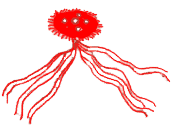
To make the string, divide the three-fourth part of the silk thread in two equal parts and plait them separately. At the end tie a knot and brush the end again.
Once this is done decorate it with beads or sitaras. Stick them with glue. You can purchase sponge of a suitable colour, cut it into a star shape, decorate it with beads or sitaras. Golden threads can be entwined used for decoration. And then stick it with glue.

Send e-Rakhi Greetings
www.rakhi-ecards.com
www.rakhi-greetings.com
www.123greetings.com/events/rakshabandhan

Krishna on his birth anniversary in the festival of Janmashtami. The temples of Vrindavan witness an extravagant and colourful celebration on this occasion. Raslila is performed to recreate incidents from the life of Krishna and to commemorate his love for Radha. The image of the infant Krishna is bathed at midnight and is placed in a cradle. Devotional songs and dances mark the celebration of this festive occasion all over Northern India.
In Maharashtra, Janmashtami witnesses the exuberant enactment of the god’s childhood endeavours to steal butter and curd from earthen pots beyond his reach. A matka or pot containing these is suspended high above the ground and groups of young men and children form human pyramids to try and reach the pot and eventually break it.

Onam, the principal festival of Kerala, is celebrated against a setting of lush green vegetation. This picturesque harvest festival brings ten days of colour feasting, boat races, song and dance to the state.
According to legend, the state’s most colourful festival, Onam celebrates the golden age of King Mahabali, the mythical ruler of Kerala. The festival is to welcome the spirit of King Mahabali, and to assure him that his people are happy and wish him well. The myth goes like this:
The Devas or Gods were worried over the wise and good rule of Mahabali, the Asura king, thinking that he might become too powerful. They sought the help of Vishnu (the preserver in the Hindu trinity) to curb Mahabali’s power. Vishnu, in the form of a dwarf called Vamana, approached him and had been offered a boon by the king. The Vamana asked for three paces of land and the king agreed to it. Soon the dwarf began to expand and with the first step, he covered the sky, blotting out the stars, and with the second, he straddled the nether world.


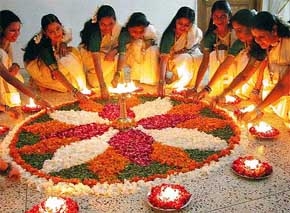

Date : Aashwayuja Shukla Dashami
Dusserah, also known as Vijayadashmi, is celebrated on the tenth day, which follows nine days of Durga Pooja, some time in September / October.
The Tenth day of the bright half of the lunar month of Aashwayuja.
This is among the most auspicious days in the Hindu calendar and comes as the finale of the nine-day festival, Navaraatri. This festival of victory is preceded by worship of Saraswati the Goddess of Learning and of Durgaa the Goddess of Strength. This is among the most auspicious days in the Hindu calendar and comes as the finale of the nine-day festival, Navaraatri. This festival of victory is preceded by worship of Saraswati the Goddess of Learning and of Durgaa the Goddess of Strength.
Various have been the names of the Goddess of Strength – Durgaa, Mahaa Kaali, Mahishasura Mardini etc., under which that supreme protectress of the good and the holy put to rout, time and again, the demoniac forces and established the supremacy of the righteous.
The story of how Mahishaasura Mardini took birth is striking for its unique message. At one stage the Gods felt powerless against the onslaughts of the demoniac forces headed by Mahishaasura. In answer to their prayers for protection, they were ordered to part with a portion of their divine powers to form into a new Goddess. It was thus that Mahishaasura Mardini took on a physical form as the combined might of 33 crores of Gods. The dreaded demon Mahishaasura was slain by Chaamundeshwari after a ceaseless fight of nine days and nights.
The lesson of this legend is so beautifully clear. Even the good and the righteous can succeed against the evil forces only when they come together in an organized endeavour. Could there be a more telling message to the present-day disorganized Hindu people – many of them individually good and pious but who have remained incapable of overcoming the forces inimical to them and their culture? Truly has it been said, ‘Sanghe shaktih kalau yuge’ – Organization holds the key to strength in Kaliyuga. And this is the one single, most important lesson which the Hindu people have to learn today.
Every page of our past history bears testimony to the shocking phenomenon of how the Hindus, though immensely superior in culture, wealth, armies, territory and sheer numbers to the foreign aggressors, were defeated and enslaved. And all this tragedy because of their fatal drawback of disorganization. Now, it is high time the Hindus learnt the bitter lesson of the past and realize that “Organization is life and disorganization is death”.
The unique concept of worship of strength in the Hindu tradition is far, far removed from that of accumulation of aggressive power. This strength is termed nigrahaanugraha shakti, i.e., while on the one hand it destroys the wicked, on the other it protects the good and the holy. That is how we find that the rise of Hindu power was never attended by aggression and exploitation of other countries. Probably the only nation on the face of the earth to display this rate restraint has been the Hindu Nation. The world history is replete with the blood curdling stories of nation after nation, whenever they became powerful, embarking upon barbaric invasions of other countries and liquidating whole native races. It was given to the Hindu Nation alone to live up to the famous saying of Jesus Christ, “I have come to fulfil, and not to destroy”.
Vijaya Dashami is resplendent with many an inspiring episode reflecting the victorious culmination of deeds of valour of our illustrious ancestors. The tradition in southern parts depicts Sri Rama’s triumphant return to Ayodhya after fourteen years of banishment entailing endless hardships, dangers and mental anguish like separation from Sita and finally the slaying of Raavana, as coinciding with this day. Symbolic of the victorious occasion, Raama-Leela is observed with great enthusiasm and eclat in the northern parts.

Shree Raama, it is said, worshipped Shami tree before proceeding to Ayodhya. On the same day, the Paandavas too, took out their arms hidden in the Shami tree and revealed their identity after their one year of Ajnaatavaasa (living incognito) after twelve years of exile to a forest. That marked their preparation for the victorious war of Kurukshetra. Invoking these inspiring memories the Shami is worshipped on this day and the holy leaves are distributed by one another as an auspicious omen for the coming year. The following couplet is repeated on the occasion:
Shamee shamayate paapam shamee shatruvinaashinee|
Arjunasya dhanurdhaaree Raamasya priyadarshinee||
(Shami, the remover of all sins, the destroyer of all enemies bore witness to Arjuna taking his bow and Shree Raama coming back to his near and dear ones.)
The Hindu kings and chieftains in the medieval period like Vijayanagar kings and Maratha Peshwas continued this tradition of worshipping the Shami tree and marching in royal procession. Many a time they would sally forth against their foes – Seemollanghana – on this day. Even to this day, amidst the heartrending ruins of Hampi in Karnataka – the site of the once worldfamed Vijayanagar stands the Vijaya Dashami pedestal on which Krishna Devaraya, the celebrated monarch, used to stand and receive the salute of his half-a-million strong army.
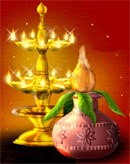
Date: A family festival, it is celebrated 20 days after Dussehra, on the 13th day of the dark Fortnight of the month of Ashwin (October / November)
Deepawali or Diwali The 14th Day of the dark half of Aashwayuja to the 2nd day of bright half of Kaartik If there is one occasion which is all joy and all jubilation for one and all – the young and the old, men and women for the entire Hindu world, it is Deepaavali – the Festival of Lights. Even the humblest of huts will be lighted by a row of earthern lamps.
Crackers resound and light up the earth and the sky. The faces of boys and girls flow with a rare charm in their dazzling hues and colors. Illumination – Deepotsavas – in temples and all sacred places of worship and one the banks of rivers symbolize the scattering of spiritual radiance all round from these holy centres.
The radiant sight of everybody adorned with new and bright clothes, especially ladies decorated with the best of ornaments, captures the social mood at its happiest. And all this illumination and fireworks, joy and festivity, is to signify the victory of divine forces over those of wickedness.
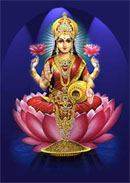
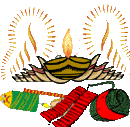
Narakaasura was a demon king ruling over Praagjyotishapura (the present-day Assam). By virtue of his powers and boons secured from God, he became all-conquering. Power made him swollen-headed and he became a menace to the good and the holy men and even the Gods. The Gods headed by Devendra implored Sri Krishna who was at Dwaaraka (in the present-day Gujarat) to come to their rescue. Sri Krishna responded.
He marched from the western end of the country to its eastern end, Praagjyotishapura, destroyed the huge army which opposed him finally beheaded Narakaasura himself. The populace was freed from the oppressive tyranny and all heaved a sigh of relief. The 16,000 women kept in captivity by the demon king were freed. With a view to removing any stigma on them and according social dignity, Sri Krishna gave all of them the status of his wives. After the slaying of Narakaasura Sri Krishna bathed himself smearing his body with oil in the early morning of Chaturdashi. Hence the invigorating vogue of taking an early morning `oil-bath’ on that day. Mother Earth, whose son Narakaasura was, requested Sri Krishna that the day be celebrated as one of jubilation. Sri Krishna granted the request and since then the tradition has continued.
Mother Earth reconciled herself to the loss of her son and knowing as she did that the Lord had punished her son for the sake of the welfare of the world, she set a glowing example of how one has to brush aside one’s personal joys and sorrows in the interest of society. It is this deliverance of the people from the clutches of the asuras that fill the people with joy. Then follows Amaavaasya, the new moon day, auspicious for offering prayers and gratitude to the bygone ancestors of the family and invoking their memories and blessings for treading the path of right conduct. This is also the sacred occasion for the worship of Mahaa Lakshmi, the goddess of Wealth and Prosperity. The business community open their New Year’s account with Her worship. This reminds us of the famous saying of the sage Vyaasa, ‘dharmaadarthashcha kaamashcha…’ – it is through right conduct that wealth and fulfilment of desires also accrue. In northern parts of Bharat, Deepaavali is associated with the return of Sri Rama to Ayodhya after vanquishing Raavana. The people of Ayodhya, overwhelmed with joy, welcomed Rama through jubilation and illumination of the entire capital. Well has it been said that while Sri Rama unified the north and south of our country, Sri Krishna unified the west and the east. Sri Rama and Sri Krishna together therefore symbolize the grand unity of our motherland. The third day, i.e., the first day of Kaartik, is named Balipratipada, after the demon king Bali, the ruler of Paataala (the netherworld), who had extended his kingdom over the earth also. On the day, Sri Vishnnu, taking the form of a dwarfish Brahmin by name Vaamana, approached Bali, for a boon of space equal to his three steps. Bali, known for his charity, gladly granted the boon. Vaamana now grew into a gigantic form; with one step he covered the entire earth, with the second he covered the outer sky, and asked Bali where he should keep his third step. Bali, left with no other choice, showed his own head. Sri Vishnu placed his foot on Bali’s head and pushed him down to the netherworld, the rightful territory of Bali’s reign. However, Bali prayed to the Lord that he might be permitted to visit the earth once a year.
Now it was the turn of Vishnu to grant the boon. And the people too offer their and respect to him on this day. The annual visit of Bali is celebrated in Kerala as Onam. It is the most popular festival for Kerala where every Hindu home receives him with floral decorations and lights and festoons adorn all public places. Onam, however, falls on the 16th day of Aavani (Sowramaana) in september. The pratipada is also the day for Govardhana Pooja and Anna Koota (heap of grains), the former signifying the Govardhana episode in Sri Krishna’s life and the latter conveying affluence and prosperity. The fourth and final day is Yama Dwiteeya, also called Bahu beej. It is a most touching moment for the family members when even distant brothers reach their sisters to strengthen that holy tie. The sister applies tilak and waves aarati to her brother, and the brother offers loving presents to the sister. To the Jains, Deepaavali has an added significance to the great event of Mahaaveera attaining the Eternal Bliss of Nirvaana. The passing into Eternity on the same Amaavaasya of Swami Dayananda Saraswati, that leonine sanyasin who was one of the first to light the torch of Hindu Renaissance during the last century, and of Swami Ramatirtha who carried the fragrance of the spiritual message of Hindu Dharma to the western world, have brought the national-cum-spiritual tradition of Deepaavali right up to modern times.

Coming with the new moon, this festival marks the end of Ramzan, the ninth month of the Muslim year. It was during this month that the holy Koran was revealed. Muslims keep a fast every day during this month and on the completion of the period, which is decided by the appearance of the new moon, Id-ul-Fitr is celebrated with great eclat. Prayers are offered in mosques and Idgahs and elaborate festivities are held.
Id-ul-Azha or Id-ul-Zuha (Bakr-Id)
The Id-ul-Azha commemorates the ordeal of Hazrat Ibrahim, who had been put to a terrible test by God when he was asked to sacrifice whatever was dearest to him and he decided to sacrifice the life of his son. As he was on the point of applying the sword to his son’s throat, it was revealed to him that this was meant only to test his faith, and it was enough, if instead he sacrifices only a ram in the name of Allah. This is celebrated on the tenth day of Zilhijja, when the Haj celebrations at Mecca are rounded off by the sacrifice of goats or camels. In India, too, goats and sheep are sacrificed all over the country and prayers are offered.

Id-i-Milad (Barah-wafat)
The Prophet was born on the twelfth day of Rabi-ul-Awwal, the third month of the Muslim year. His death anniversary also falls on the same day, the word ‘barah’ standing for the twelve days of the Prophet’s sickness. During these days, sermons are delivered in mosques by learned men, focusing on the life and noble deeds of the Prophet.
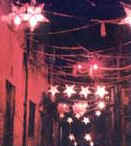
Date: 25th December
The history of Christmas dates back over 4000 years. Many of our Christmas traditions were celebrated centuries before the Christ child was born. The 12 days of Christmas, the bright fires, the yule log, the giving of gifts, carnivals(parades) with floats, carolers who sing while going from house to house, the holiday feasts, and the church processions can all be traced back to the early Mesopotamians.
Many of these traditions began with the Mesopotamian celebration of New Years. The Mesopotamians believed in many gods, and as their chief god – Marduk. Each year as winter arrived it was believed that Marduk would do battle with the monsters of chaos. To assist Marduk in his struggle the Mesopotamians held a festival for the New Year. This was Zagmuk, the New Year’s festival that lasted for 12 days.
The Mesopotamian king would return to the temple of Marduk and swear his faithfulness to the god. The traditions called for the king to die at the end of the year and to return with Marduk to battle at his side.
To spare their king, the Mesopotamians used the idea of a “mock” king. A criminal was chosen and dressed in royal clothes. He was given all the respect and privileges of a real king. At the end of the celebration the “mock” king was stripped of the royal clothes and slain, sparing the life of the real king.
The Persians and the Babylonians celebrated a similar festival called the Sacaea. Part of that celebration included the exchanging of places, the slaves would become the masters and the masters were to obey.
Early Europeans believed in evil spirits, witches, ghosts and trolls. As the Winter Solstice approached, with its long cold nights and short days, many people feared the sun would not return. Special rituals and celebrations were held to welcome back the sun.
In Scandinavia during the winter months the sun would disappear for many days. After thirty-five days scouts would be sent to the mountain tops to look for the return of the sun. When the first light was seen the scouts would return with the good news. A great festival would be held, called the Yuletide, and a special feast would be served around a fire burning with the Yule log. Great bonfires would also be lit to celebrate the return of the sun. In some areas people would tie apples to branches of trees to remind themselves that spring and summer would return.
The ancient Greeks held a festival similar to that of the Zagmuk/Sacaea festivals to assist their god Kronos who would battle the god Zeus and his Titans.
The Roman’s celebrated their god Saturn. Their festival was called Saturnalia which began the middle of December and ended January 1st. With cries of “Jo Saturnalia!” the celebration would include masquerades in the streets, big festive meals, visiting friends, and the exchange of good-luck gifts called Strenae (lucky fruits).
The Romans decked their halls with garlands of laurel and green trees lit with candles. Again the masters and slaves would exchange places.
“Jo Saturnalia!” was a fun and festive time for the Romans, but the Christians though it an abomination to honor the pagan god. The early Christians wanted to keep the birthday of their Christ child a solemn and religious holiday, not one of cheer and merriment as was the pagan Saturnalia.
But as Christianity spread they were alarmed by the continuing celebration of pagan customs and Saturnalia among their converts. At first the Church forbid this kind of celebration. But it was to no avail. Eventually it was decided that the celebration would be tamed and made into a celebration fit for the Christian Son of God.
Some legends claim that the Christian “Christmas” celebration was invented to compete against the pagan celebrations of December. The 25th was not only sacred to the Romans but also the Persians whose religion Mithraism was one of Christianity’s main rivals at that time. The Church eventually was successful in taking the merriment, lights, and gifts from the Saturanilia festival and bringing them to the celebration of Christmas.
The exact day of the Christ child’s birth has never been pinpointed. Traditions say that it has been celebrated since the year 98 AD. In 137 AD the Bishop of Rome ordered the birthday of the Christ Child celebrated as a solemn feast. In 350 AD another Bishop of Rome, Julius I, choose December 25th as the observance of Christmas.
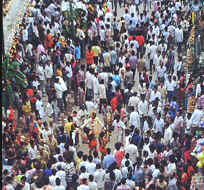
Bonalu – This is a festival of offering to Godess Mahankali. This folk festival of Bonalu is famous in the Telangana region brings an offering to the Godess Mahankali. The Mahankali temple is located in the busy streets of Secunderabad area. The festival period starts in this region and continues for every week in different places.
The Dance of balancing pots with the colourfully dressed female danceres balancing pots (Bonalu), step to the rythemic beats and tunes in praise of the village diety Mahankali. Male dancers called the Potharajus follow the female Dancers to the temple lashing whips and emerald margosa leaves tied around their waists adding colour to the roaring trumpets and pulsating percussion.
